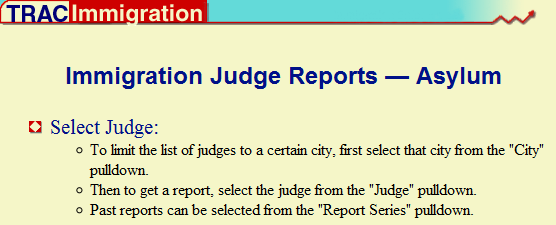Very timely Justice Department data show that Immigration Judges are declining substantially fewer requests for asylum. Denial rates have reached the lowest level in the last quarter of a century according to a new analysis by the Transactional Records Access Clearinghouse (TRAC).
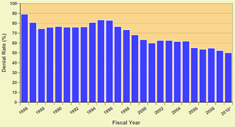
Figure 1. Asylum Denial Rates in Immigration Courts (click for details). |
Twenty five years ago, in FY 1986, almost nine out of ten (89%) of the asylum requests in the Immigration Courts were denied. While the annual rates have gone up and down during the ensuing years, only half (50%) of the requests were denied during the first nine months of FY 2010 — a record low.
One factor contributing to the improved success of the asylum seekers is that a higher proportion of the total are represented by counsel. It must be noted, however, that the number of those seeking asylum in court proceedings has fallen.
These and many other findings have emerged in the fifth annual report of TRAC's monitoring series on Asylum Decisions in the Immigration Courts. The reports are based upon hundreds of thousands of case-by-case asylum records obtained under the Freedom of Information Act from the Executive Office for Immigration Review (EOIR). The records cover asylum decisions for the last quarter century, and are current through June 21, 2010.
Emerging from TRAC's systematic long-term examination of the government's handling of asylum are several key findings:
![]() The denial rate for asylum requests in Immigration Court has been steadily declining since the mid-nineties, and is projected to fall again in FY 2010. In FY 1986 almost nine out of ten requests (89%) were denied. Five years ago slightly more than six out of ten requests (62%) were denied. So far this year, it has dropped further so that only five out of every ten (50%) asylum requests are being denied. See Figure 1 and Table 1.
The denial rate for asylum requests in Immigration Court has been steadily declining since the mid-nineties, and is projected to fall again in FY 2010. In FY 1986 almost nine out of ten requests (89%) were denied. Five years ago slightly more than six out of ten requests (62%) were denied. So far this year, it has dropped further so that only five out of every ten (50%) asylum requests are being denied. See Figure 1 and Table 1.
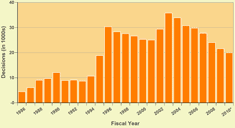
Figure 2. Volume of Immigration Court Asylum Decisions (click for details). |
![]() At the same time, the total number of asylum decisions rendered each year has been falling sharply since FY 2003, and very recent information shows the decline is continuing this year. Thus, totals for FY 2010 are projected to be down 44 percent from their peak in 2003. See Figure 2 and Table 1.
At the same time, the total number of asylum decisions rendered each year has been falling sharply since FY 2003, and very recent information shows the decline is continuing this year. Thus, totals for FY 2010 are projected to be down 44 percent from their peak in 2003. See Figure 2 and Table 1.
![]() The growing success of asylum seekers is partly attributable to increases in the proportion who obtain legal representation. The latest figures show that more than nine out of every ten (91%) are now represented, up from just over half (52%) twenty-five years ago in FY 1986. See Figure 3 and Table 2.
The growing success of asylum seekers is partly attributable to increases in the proportion who obtain legal representation. The latest figures show that more than nine out of every ten (91%) are now represented, up from just over half (52%) twenty-five years ago in FY 1986. See Figure 3 and Table 2.
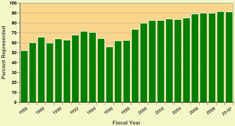
Figure 3. Representation for Asylum Cases in the Immigration Courts (click for details). |
Having legal representation appears to have a major impact on outcome. During FY 2010, for example, only 11 percent of those without legal representation were granted asylum; with legal representation the odds rose to 54 percent.
![]() As in the past, whether an individual request for asylum is approved or denied is still heavily dependent upon the judge who was assigned to decide it. As described more fully in the remainder of this report, while the judge-to-judge disparities in asylum decisions have moderated somewhat, these disparities remain substantial. For example, in the New York Immigration Court that in the FY 2008 - 2010 period handled the largest volume of asylum cases, the record shows that one judge denied asylum only 6 percent of the time, while another denied asylum 70 percent of the time. (Previously there were even wider disparities — 7 percent to 88 percent.) The judge-to-judge range in the San Francisco court was from 32 to 92 percent, and that court's disparity showed little improvement.
As in the past, whether an individual request for asylum is approved or denied is still heavily dependent upon the judge who was assigned to decide it. As described more fully in the remainder of this report, while the judge-to-judge disparities in asylum decisions have moderated somewhat, these disparities remain substantial. For example, in the New York Immigration Court that in the FY 2008 - 2010 period handled the largest volume of asylum cases, the record shows that one judge denied asylum only 6 percent of the time, while another denied asylum 70 percent of the time. (Previously there were even wider disparities — 7 percent to 88 percent.) The judge-to-judge range in the San Francisco court was from 32 to 92 percent, and that court's disparity showed little improvement.
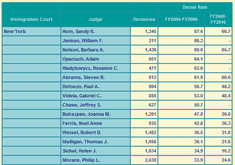
Table 3. Judge-by-Judge Asylum Decisions in Immigration Courts Before and After the Attorney General's Directive (click for table). |
Among the larger Immigration Courts, Miami had the least disparity. The denial rates of judges there ranged from 60 percent to 88 percent. To view a table with the Immigration Judges assigned in each Immigration Court and their current and previous denial rates, see updated judge-by-judge listing.
The 2010 reports on each individual Immigration Judge, with year-by-year denial rates and current comparative rankings, can be viewed at TRAC's judge-by-judge menu page. There you can access the current as well as previous annual reports that TRAC has issued on individual Immigration Judges. Note: to be included in this series, a judge must have made at least 100 asylum decisions during the reporting period.
Equal Justice Under the Law
A court system where all the judges in it decide the cases they are handling in the same way, regardless of the underlying facts, is the very opposite of justice. Because the facts in each case are different, the ultimate decisions in them should differ too. The central goal, therefore, is not to eliminate all differences in outcome but to assure that the judges constantly seek to recognize the valid claims of those who come before them and deny the claims that are legally insufficient.
If Judge A's denial rate in Miami or San Francisco is higher than Judge B's denial rate in New York or Los Angeles, this alone does not imply that Judge A's decisions are somehow biased. It is entirely possible that fewer valid claims came before Judge A's court and that this fact accounts for Judge A's higher denial rate. The makeup of cases heard by different Immigration Courts around the country can be quite varied.
It is reasonable, however, to compare denial rates of judges sitting on the same Immigration Court. This is because EOIR says cases coming into each particular court are assigned at random among that court's judges. Assigning cases in this manner ensures that the workload of each judge on the same court will have roughly the same proportion of asylum seekers with valid claims when there are a substantial number of asylum cases. (As noted above, TRAC limits its comparisons to judges who have decided a large number of asylum cases.) This means that the differences documented in the denial rates among judges are truly "disparities." They cannot be explained by differences in the legitimacy of asylum seekers' claims.
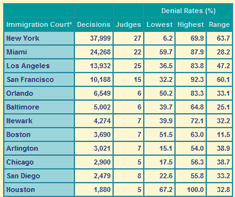
Table 4. Extremes in Court-by-Court Disparity, FY 2008-2010 (click for table). |
It is now well documented [1] that the particular judge who decides an asylum case has a major impact on whether asylum is granted. The latest figures covering FY 2008 – 2010 continue to show large judge-to-judge disparities. The average disparity in denial rates among judges sitting on the same court was 39 percentage points. If the outcome of the individual courts are weighted according to the volume of asylum decisions they render [2], the average disparity is even higher (46 percentage points). See Table 4.
These results are based on decisions made in fourteen of the busiest courts hearing asylum cases. The cases they decided accounted for 82 percent of all asylum decisions in the United States. (A key qualifying factor was that each of the fourteen had at least 4 judges who had decided a sufficient number of asylum cases to be reliably assessed.)
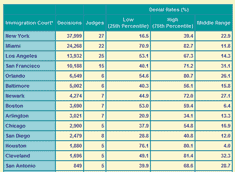
Table 5. Middle Fifty Percent of Court-by-Court Disparity, FY 2008-2010 (click for table). |
TRAC's research also demonstrates that the problem of disparity is not limited to a few "outlier" judges who decide cases differently from their fellow judges on the court. To test this, we removed from the analysis for each court a quarter of the judges with the highest denial rates along with a quarter of the judges with the lowest denial rates. The remaining 50 percent of the judges in the middle still show considerable disparities — 19 percentage points on average — among their decisions. See Table 5 for these details.
The Persistence of Disparity: Did Recent Reforms Help?
Wide disparities in asylum decisions are not a new problem. As TRAC has reported in each of its previous annual reports in this series [1], judge-to-judge differences in their denial rates have persisted for every time period TRAC examined going back to 1994, the earliest data then available. Over this lengthy time period the judges sitting on the Immigration Courts have changed. Many judges serving in 1994 have left the bench and many new judges have since been hired. Yet, as the results above continue to demonstrate, the problem persists.
In August 2006, shortly after TRAC published its first report on asylum decision disparities, then Attorney General Gonzales directed EOIR to review TRAC's study and if the findings proved valid to recommend reforms to reduce the disparity. In response to the AG's directive, EOIR did undertake a study of the judge-by-judge asylum denial rates, and confirmed that some judges had inexplicably low denial rates while others were unusually high. EOIR directed the Immigration Judges to focus more attention on this area, primarily by instituting some additional training and ordering monitoring of judges with unusually high and low asylum denial rates. Additional recommendations came from the General Accountability Office after it conducted its own study. It was published in September 2008 and fully confirmed the existence of widespread asylum decision disparities.
Further, beginning in 2006, TRAC developed an online system where Immigration Judges themselves were able to compare their own asylum denial rates with those of every other judge – information they previously had not been able to access. This information came from our analysis of detailed information about the record of each individual judge. Reports on the judges were published annually beginning in 2006. This means that since that time practitioners, immigration rights groups, the media and the judges themselves have been able to easily check an important aspect of how these officials were performing.
Did this increased attention make any difference? The short answer is yes it did. TRAC analyzed the extent of asylum decision disparities today (FY 2008 – 2010) and compared them with the levels just prior to the AG's 2006 directive and growing public attention to this problem area. In total, for each period, there were thirteen courts that had at least 4 judges who had made a sufficient number of decisions to be included. The numbers show that disparities have been reduced from the levels seen during FY 2004 – 2006.
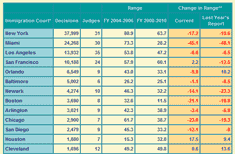
Table 6. Extremes in Court-by-Court Disparity Before and After the Attorney General's Directive (click for table). |
On average disparity levels have dropped by about 10 percentage points. If courts are weighted by the volume of asylum decisions they render the average drop in disparity was even larger (18 percentage points).[2] While there were exceptions, most courts (10 out of 13) experienced declines. See Table 6.
Whether this was a one time decline, or whether decision disparities are continuing to fall, will take more time to reliably assess. TRAC did compare the results from last year's report for the period (FY 2007 – 2009) with this year's report (FY 2008 – 2010). With two out of the three years in common, only a fairly dramatic year-to-year change would be detectable from background noise. While specific figures varied somewhat from court to court – often the result of changes in judges who were serving on a particular court – in general, the magnitude of the drop in disparity levels since FY 2004 – 2006 period was roughly comparable this year from what TRAC reported last year. In last year's report, the average decline was 10.6 percentage points as compared with 10.3 in this year's report, and the weighted average was 20.3 as compared with 17.8 currently.[2] Ten out of 13 courts showed declines each time, but two courts shifted between whether disparity went up or went down. Again, see Table 6.
Thus, although disparities have been reduced, the unfortunate bottom line remains. A very important element in deciding whether an asylum seeker is granted or denied asylum has little to do with the legitimacy of his or her claims, but a great deal to do with the particular judge to whom the asylum seeker was assigned.
Disparity in Outcomes for Asylum Seekers from Different Countries
TRAC also examined asylum denial rates by the country of origin for each of the two periods — FY 2004 to FY 2006 and FY 2008 to FY 2010. As one can see from Figure 5, there has been a decline in the overall numbers of asylum seekers across these two time periods, as well as changes in country rankings. A few countries such as El Salvador increased its number of asylum seekers, while more commonly countries like China and Columbia experienced declines.
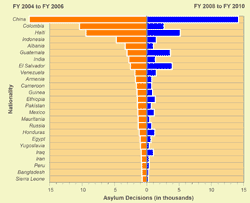
Figure 5. Number of Asylum Decisions by Nationality Before and After the Attorney General's Directive (click for details). |
Table 7 presents the number of asylum decisions and the denial rate, by nationality in each of these two time periods. Among those countries with at least 50 asylum decisions, during the latest period Jamaica had the highest asylum denial rate of 96 percent. Table 7b presents the same data, but sorted by denial rate.
Only eight nationalities had a sufficient number of asylum cases within a particular Immigration Court to allow meaningful comparison of judge-to-judge decision disparities. The eight nationalities were: China, Colombia, El Salvador, Ethiopia, Haiti, India, Iraq and Venezuela.
Judge-to-judge decision disparities for these eight nationalities for the FY 2008 – 2010 period were again quite large. The average disparity between judges sitting on the same court deciding cases on asylum seekers from the same country was 37 percentage points. When results were weighted by the volume of cases each court decided, the disparity levels that individual asylum seekers experienced rose to 54 percentage points.[2] Thus, judge-to-judge disparity differences do not substantially change when they are examined by various nationalities. See Table 8.
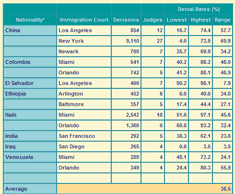
Table 8. Nationality and Court-by-Court Disparity: Examining the Extremes, FY 2008-2010 (click for table). |
There were two notable exceptions. In the Los Angeles Immigration Court, all judges denied over 90 percent of asylum claims for individuals from El Salvador, while in the San Diego court virtually all those from Iraq were granted asylum. Interestingly, these two nationalities represented the two extremes nationally on their denial rates. As shown earlier in Table 7b, over 90 percent of asylum seekers from El Salvador nationwide are denied asylum – just after 1st and 2nd place Jamaica and Guyana who had too few asylum applicants to be included in Table 8. Iraqis in turn have the highest success rate among all groups with any sizable applicant pool with 87 percent granted asylum nationwide. Countries, of course, at the polar extremes represent countries where there is widespread consensus among judges about how their cases should be decided.
As before, the problem of disparity was not limited to a few "outlier" judges who decided cases differently from their fellow judges on the court. After removing from the analysis a quarter of the judges with the highest denial rates for a given nationality and court along with a quarter of the judges with the lowest denial rates, the middle 50 percent of the judges remaining still show considerable disparities — 21 percentage points on average — among their decisions (26 percentage points if courts are weighted by their volume of asylum cases).[2] Clearly, controlling for nationality does not reduce judge-to-judge disparity levels even among the judges that fall in the middle of the range. See Table 9 for these details.
Thus, in general, a key factor determining whether asylum was granted remains which judge individuals were assigned.
Deficiencies in EOIR Record Keeping Practices
To address the persistent problem of judge-to-judge disparities in asylum decisions, the EOIR, Congress and other institutions of oversight need accurate data about these decisions. However, as TRAC reported last year, EOIR appears to have left it up to the Immigration Judges themselves to determine whether some of their decisions to refuse asylum requests are recorded as a "denial" or as an "other completion." Marking the outcome as an "other completion" means that it is mixed in with purely administrative reasons for a case closure (e.g. change in venue), and is therefore excluded from calculating denial rates.
EOIR's own internal analysis in its 2006 in response to the AG's directive found a lack of clarity in the practices used by judges when recording a decision not to grant asylum as a "denial" versus an "other completion." Now four years later even though EOIR has transferred to a newer and more flexible database tracking system, the agency has not taken sufficient steps to improve reporting standards so that actual asylum decisions are recorded in a more consistent and detailed manner.
This means that individual Immigration Judges can portray themselves as less "extreme" in their denial rates simply by altering how they record their decisions. These recording changes in turn can substantially alter our nationwide picture of how the asylum system is working.
EOIR's failure to take these simple practical steps to improve its recording and reporting practices raises serious questions about whether the agency has any enduring commitment to addressing the widespread and continuing problem of asylum decision disparity.
[1] Each year beginning in 2006 TRAC has published a report series on individual Immigration Judges examining each judge's then current asylum denial rate. In addition to these judge-by-judge reports, TRAC has conducted a series of research studies analyzing asylum decision disparities. Results from these studies were published in July 2006, September 2007, and June 2009. Earlier on October 18, 2000 investigative reporter Frederick N. Tulsky, with assistance from Dwight Morris, published an extensive analysis in the San Jose Mercury News documenting wide disparities in how asylum cases were being decided. The Stanford Law Review in 2007 [vol. 60, no. 2 (2007), pp. 295-412] published another study authored by J.Ramji-Nogales, A. I. Schoenholtz, and P. G. Schrag entitled "Refugee Roulette: Disparities in Asylum Adjudication." As noted above, the General Accountability Office also published its own study in September 2008 entitled "U.S. Asylum System: Significant Variation Existed in Asylum Outcomes across Immigration Courts and Judges."
[2] TRAC used a number of statistics to characterize the extent of disparity as well as changes in disparity that have occurred. This was because boiling data down into a single statistic rarely paints an adequate picture of what has taken place.
-
Measuring disparity. First, disparity was measured as the difference between denial rates between the judges at the extremes — those with the highest and lowest denial rate on a given court. [Statisticians refer to this statistic as the "range."] Second, after setting aside judges that had high and low denial rates, TRAC then focused on the judges whose denial rates were in the middle for a given court, and measured the difference between the denial rates of this middle fifty percent. [Statisticians refer to this statistic as the "interquartile range."] This helped answer the question as to whether disparity was the result of one or two judges on a court having unusually high (or low) denial rates relative to their fellow judges, or whether a much wider number of judges appeared to use different standards in deciding cases. (We can rule out that these differences arose because of differences in the legitimacy of asylum seeker claims because EOIR says that cases were randomly assigned among judges serving on the same court. Thus, since TRAC was only comparing judges who made a substantial number of asylum decisions, the makeup of cases each judge decides should have roughly the same proportion of legitimate asylum claims.)
Summarizing disparity measures. TRAC then summarized these court-by-court disparity figures in order to provide an overall or national picture. Again, because a single statistic may not give a full picture of the results, four statistics were presented. The most familiar of these is the average — which simply added up the individual court disparity figures and divided by the number of courts. The median was also reported which gives the disparity number for the "middle" figure — half of the courts were higher, half were lower. The volume of asylum decisions each court made varies substantially. Since more asylum seekers appear in some courts than others, to better typify the experience of asylum seekers, TRAC also adjusted or "weighted" each court's disparity figure by the volume of asylum cases decided in that court. The effect in this case was that those courts that had rendered more decisions had a greater influence on the "weighted average" and "weighted median" than those courts that had rendered fewer decisions.
Disparity measures by nationality. TRAC carried out a parallel analysis using these same statistics to examine disparity for asylum seekers sharing the same nationality that also were decided in a given Immigration Court. The statistics used were the same, except that these statistics were computed separately for each nationality group in a particular court, and then summarized across courts and nationality groups.
